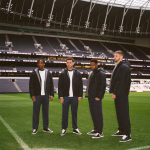
The Super Bowl stadium it's a glimpse into the future
The SoFi Stadium in Los Angeles is the new benchmark in what a big sports venue will look like
February 11th, 2022
On Monday night, the Cincinnati Bengals and Los Angeles Rams will take the field to play Super Bowl LVI, but the field where they will do so will not be trivial. First of all, because SoFi Stadium, the spatial arena inaugurated in September 2020 in Inglewood, is the home of the Rams, who thus become the second team in NFL history to play the Super Bowl on friendly ground after the Tampa Bay Buccaneers last year. But above all, SoFi Stadium is set to become the new benchmark when it comes to stadiums for major events, the benchmark for all future facilities dedicated to attracting sports spectacles thanks to a revolutionary design and a pharaonic investment.
Costing $5.5 billion, SoFi Stadium occupies the spot once dominated by Hollywood Park Racetrack near both LAX airport and the Forum, the stadium that will become the next home of the Los Angeles Clippers. It was designed by HKS to accommodate 70,000 spectators that can become 100,000 on special occasions such as the Super Bowl. A structure that seems to have come from the future, with its sail-like shape that covers not only the football stadium, but also a cavea for 6,000 spectators and a large square that will welcome the many fans or just passers-by who want to admire the lake and the surrounding park of over 120 hectares that provides a green oasis in the middle of the Los Angeles freeways.
In fact, despite its monumental size, the architects have worked to ensure that the stadium is as sustainable as possible, using the huge aerodynamic structure to channel the air coming from the coast and ensure natural refrigeration without the need for A/C systems. And the semi-transparent roof built with dozens of panels that open and close by directing themselves to let in more light or to keep water from ruining the course of an event, creating a space that can be shaped for any eventuality. Another of the challenges that the HKS studio had to overcome to build the SoFi Stadium was that brought by the proximity to the airport, which prevented the development of the stadium in height not to disturb air traffic. The solution was therefore to bury part of the stadium, digging for over 30 meters and creating a moat that not only ensures the stadium its relaxed appearance but, thanks to the supporting pillars, allows it to be earthquake-proof in an area historically at risk.
Finally, the most distinctive aspect of SoFi Stadium, the giant LED ring that overlooks and embraces the playing field. Weighing 1000 tons, it represents the largest screen in a sports facility and will be the main attraction not only of the Rams and Chargers games but also of the many concerts and exhibitions that will color the stadium beyond the usual Sunday battles. A facility that will transform the Inglewood area, one of the least affluent in Los Angeles, and that for this reason has already sparked much controversy for the impact on the community and the inevitable gentrification. Meanwhile, with the next Super Bowl, SoFi Stadium is ready to become the ideal stage for a global spectacle, which will perform in the canonical Half-Time Show Dr. Dre, Eminem, Snoop Dogg and Kendrick Lamar, and bring for one night our idea of sporting event in the future.




















